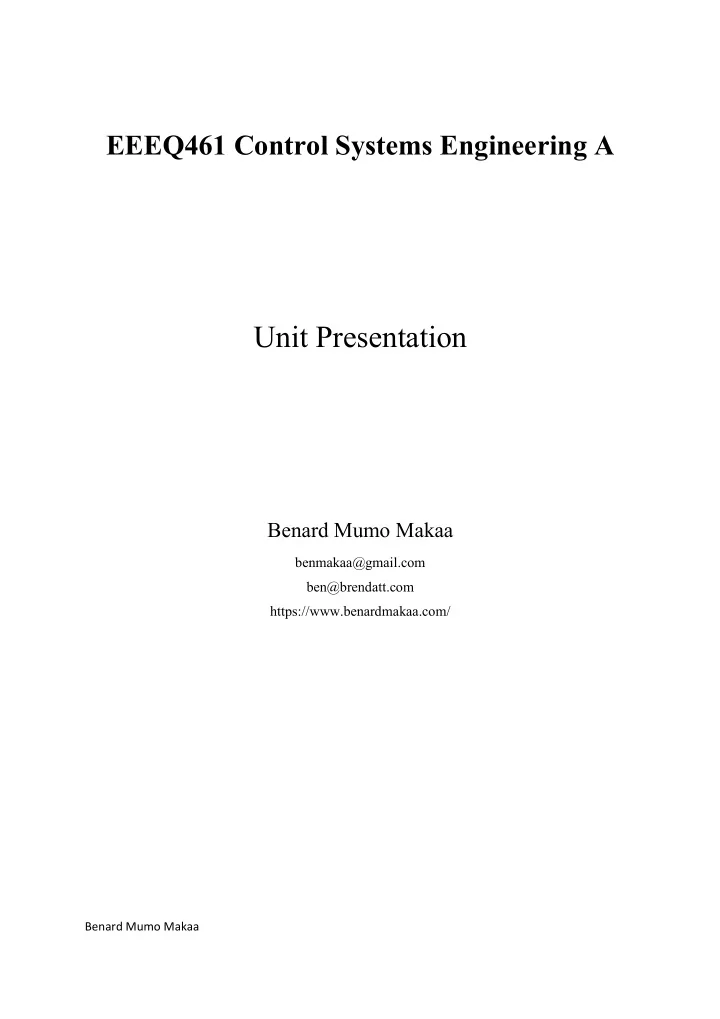

EEEQ461 Control Systems Engineering A Unit Presentation Benard Mumo Makaa benmakaa@gmail.com ben@brendatt.com https://www.benardmakaa.com/ Benard Mumo Makaa
Preliminaries: Lecture Outline: Unit Leader Details Itinerary Pre-Requisites Purpose|Aims Learning Outcomes Course Description|Content Teaching Methodology Instructional Materials/Equipment Course and Reference Textbooks Reference Journals Lecture Plan Lecture Plan-Teaching Material Benard Mumo Makaa
Unit Leader Details Name: Benard Mumo Makaa Room: N001B, N-Block Building, Technical University of Kenya. Email 1:benmakaa@gmail.com Email 2:ben@brendtt.com Website: https://www.benardmakaa.com/ Mobile No. +254716518555/+254731371542 Itinerary Lectures: Tuesday: 15.00-17.00hrs, Room E-13 Thursday: 09.00-11.00hrs, Room U-35 Tutorials: Labs: Wednesday: 13.00hrs-15.00hrs. Pre-Requisites Electric Circuit Theory IIB Purpose|Aims The aim of this course is to enable the students to; 1. Perform block diagram analysis of feedback control systems 2. Understand design of controllers using the root locus 3. Understand the design of controllers using Nyquist frequency techniques Benard Mumo Makaa
Learning Outcomes At the end of this course, the student should be able to; 1. Differentiate between the various control actions and their application 2. Select an appropriate control action for a specific design 3. Design PI,PD and PID controllers Course Description|Content Dynamic models and dynamic responses: Models of dynamic system in different equation form. Linearization, amplitude and time scaling. Transfer function representation of models. Time-domain effects such as rise time overshoot, setting time. Feedback control system concepts and stability: Essential principles of feedbacks. Direct block diagram modelling of feedback systems. Effect of parameter sensitivity and disturbance response, steady state error in feedback system, transient response verses steady state errors. Stability, Routh-Hurwitz stability criterion, relative stability of feedback. Determination of root location in S-plane. Root locus method: Root loci, plotting of root loci. System design using root loci. Phase lead and lag compensation using rood loci, computer aided plotting of root loci. Frequency – response methods: Frequency response functions, Bode plots, M & N N-circles. Lead-lag compensation. Frequency response performance specifications. Nyquist stability criterion, Nyquist diagram and stability, gain and phase margins, closed- loop frequency response, Stability of control system with time delays. Examples of |Frequency response design and analysis using a computer-aided control- engineering tool such as MATLAB’S Control, System Toolbox. Benard Mumo Makaa
Teaching Methodology 2-hour lecture and 1-hour tutorial per week and at least three 3-hour laboratory session per semester organized on a rotational basis. Mode of course assessment: Continuous assessment and written University examinations shall contribute 30% and 70%, respectively of the total marks. Instructional Materials/Equipment 1. Control Engineering laboratory 2. LCD projector Course and Reference Textbooks 1. Norman S. Nise, (2015) Control Systems Engineering, Wiley. 2. Distefano J. J, Stubberud A.R.,& Williams I.J (2013), Feedback and Control Systems,; Theory and Problems (Schaum’s Outline Seties) , McGraw-Hill, 2 nd Ed. 3. Ogata K. (2016), Modern Control Engineering , Prentice Hall. 4. Kuo, B.C, &Farid G. (2017), Automatic Control Systems, Wiley. 5. Gene F., (2014), Feedback Control of Dynamic Systems , Prentice Hall. Reference Journals 1. Automatic control and computer science 2. Electrika: Journal of Electrical Engineering 3. Russian Electrical Engineering 4. Computing and Control Engineering 5. Acta Electrotechnica Benard Mumo Makaa
Lecture Plan-Teaching Material LECTURE 1: Introduction to Control Systems Engineering LECTURE 2: Modelling LECTURE 3: Modelling - Representation LECTURE 4: Modelling – Time and frequency domain and transients LECTURE 5: Modelling – electrical systems LECTURE 6: Modelling – mechanical systems LECTURE 7: Time response – 1st order systems LECTURE 8: Time response – 2nd order systems LECTURE 9: Time response – step response of 2nd order systems LECTURE 10: Time response – effect of extra poles and zeros LECTURE 11: Frequency response – introduction to Bode plots LECTURE 12: Bode plots LECTURE 13: Bode plots for systems LECTURE 14: The effects of feedback LECTURE 15: Stability LECTURE 16: Evans’ Root Locus Method LECTURE 17: Procedure for plotting root loci LECTURE 18: Frequency-Domain Tests of stability LECTURE 19: Nyquist plots LECTURE 20: Stability analysis using Nyquist plots Benard Mumo Makaa
Recommend
More recommend